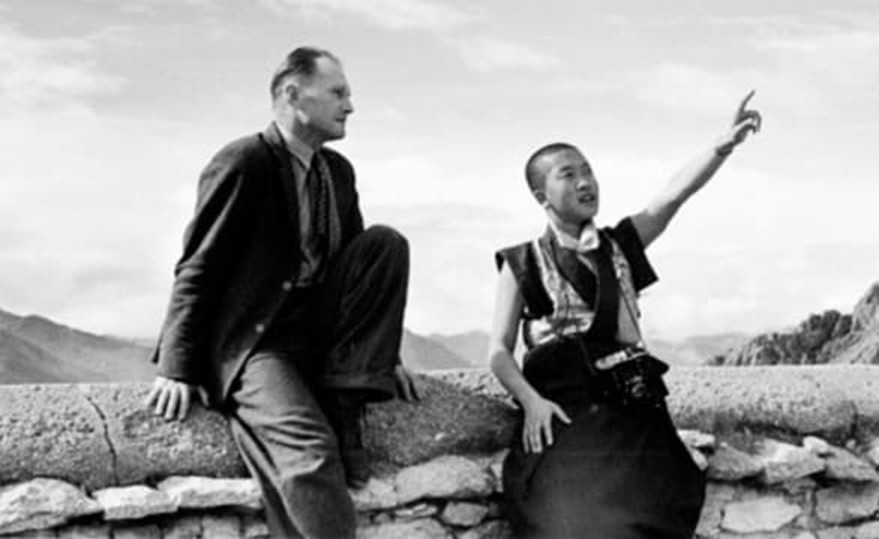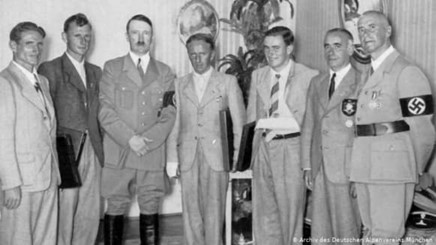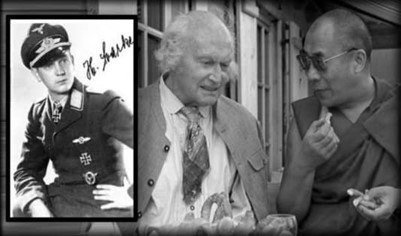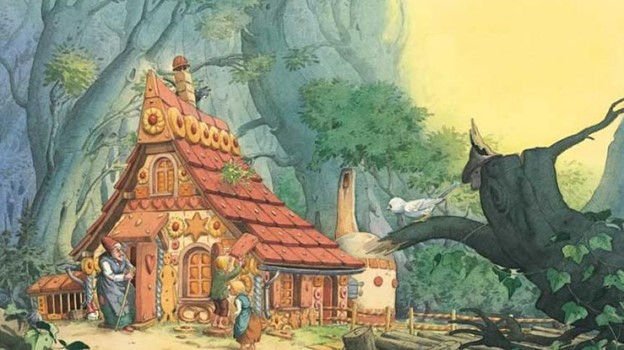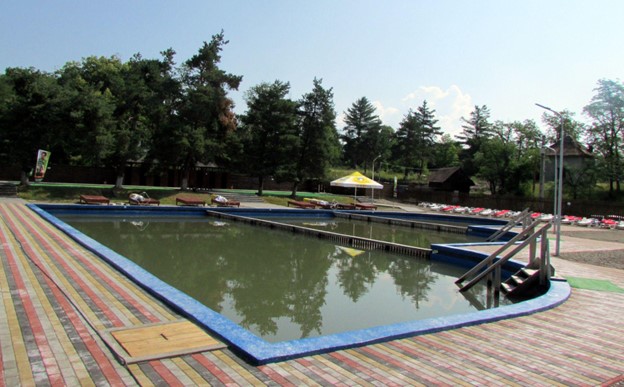Nazi occultism complemented perfectly with Tibetan Tantrism. This connection existed during World War II and has been and still is hidden today. Hitler was fascinated by Tibetan culture, while the Dalai Lama considered Fuhrer „the man supported by the gods to bring the change”.
The connection beteen Nazi occultism and Tibet
Were there occult intentions behind the “SS Schäfer Expedition”? In the neo-fascist literature these are considered a top secret mission of Himmler’s to make contact with the “adepts of Shambhala and Agarthi”. Authors like Wilhelm Landig, Miguel Serrano, Russell McCloud, etc., let their readers believe that through these expeditions a kind of metapolitical axis between Berlin and Lhasa was constructed.
Dietrich Bronder knew that:
Dietrich Bronder knows that „Schäfer’s SS soldiers were permitted to enter holy Lhasa, otherwise closed to Europeans and Christians, even the magnificent Lamaist temple that contains a huge symbol, the holiest in the Mongolian world — the swastika”.
Although in recent years comprehensive research findings about the Nazi expeditions in Tibet have been published, the truth is not fully revealed. Nazi occultism was the result of Tibetan spirituality. Ernst Schäfer and Bruno Beger, the two leaders of the SS Schäfer expedition), are depicted as sober natural scientists, who had good intentions.
On the other hand, Hitler vehemently denied occultism. However, it was clearly attracted to Tibetan culture. This is why an important connection between Nazism and Tibetan spirituality was born.
When for example, at the presentation of a gift to the Tibetan regent in Lhasa, Ernst Schäfer declaims:
„Since the swastika is also the supreme and most holy symbol for us Germans, the motto of our visit is: A meeting of the Western and Eastern swastikas in friendship and peace…”
There are certainly also other, non-fascist, authors who create an occult correspondence between national socialism and Tibetan Buddhism via a esoteric interpretation of the „Hakenkreuz” (the swastika), a Buddhist symbol par excellence:
„The rightward hooked cross [signifies] a prayer formula in Tibet”, writes Friedrich W. Doucet, „In its left-turned form — like the national socialist swastika — it designates the orthodox Yellow Hats… it is the Yellow Hats who supervise the spiritual rules in the Tibetan ecclesiastical state and also exercise worldly power”.
The Dalai Lama, a key role in the Nazi-Tibet connection
The German author Rüdiger Sunner quotes the report of a member of the “SS Schäfer Expedition” over a meeting with Wiligut (Karl Maria Wiligut was an Austrian occultist and SS-Brigadeführer). During the encounter (in 1937 or 1938?), the latter was in a trance-like state and addressed his visitors in a guttural voice:
„I telephoned my friends this evening… in Abyssinia and America, in Japan and Tibet… with all who come from another world in order to construct a new empire. The occidental spirit is corrupted, we have a major task before us. A new era will come, for creation is subject to just one grand law. One of the keys lies with the Dalai Lama [!] and in the Tibetan monasteries.”
In the 80s the Chilean Miguel Serrano took up the speculation anew that the Dalai Lama plays a key role in the Nazi-Tibet connection.
His „skill”, this author says of the fourteenth Dalai Lama, is „closely linked with that of Hitler’s Germany… on the basis of not yet discovered connections. A few years after Germany, Tibet also falls”. A strange, but very true connection made by Serrano.
The Dalai Lama and Harrer
Wiligut also believed that Lhasa would form an energetic quadrilateral with Urga (Ulan Bator), the Egyptian pyramids, and Vienna. Miguel Seranno was later to expound similar ideas (in the seventies). Himmler too was interested in geomantic ideas and it cannot be excluded „that he hoped for more exact data about this from the expeditions to Tibet.”
Geomancy is a pseudoscience that predicts the future with the help of points drawn on the earth or by analyzing some piles of earth.
The myth of the „black sun”
Nazi occultism combines with Tibetan occultism. The myth of the “black sun”, which was able to win a central place in the neo-fascist movement, displays similarities with the Tibetan Rahu myth from the Kalachakra Tantra.
In a commentary on Wiligut’s runic writings, a pupil, Emil Rüdiger, mentions an invisible dark planet, Santur by name, which is supposed to influence the destiny of mankind. This is the black sun, which can only be seen through yoga exercises. These exercises are not available to anyone. Their secret is only known by Buddhist monks.
Here, racist Nazi myths have been fused with elements of the Tibetan Shambhala myth and with sexual magic practices from Tantric Buddhism.
In this process of myth construction, one must not forget the meetings between the Dalai Lama and former SS members (Schäfer, Harrer, Beger). These have occult significance alone by virtue of the fact that anybody who mentally negotiates an esoteric network interprets a meeting with the Dalai Lama as an occult event.
Nazi occultism, Tibetan paradigms
The following list of paradigms, concepts, theories, methods, and myths which have essentially shaped the culture of Lamaism (and still do) have become central for the neo-fascist movement:
- The combination of religious and political power;
- A strictly hierarchical state structure that rests upon a spiritually based „Führer principle”;
- The patriarchal orientation of the state and society;
- A pattern of complete subordination of pupil to master;
- The appearance of divine beings on earth to fulfill political missions (the avatar, incarnation, and Bodhisattva principle);
- A political micro-/macrocosmic theory according to which a Buddhist ruler represents a likeness of the entire universe;
- The idea of a world ruler (Chakravartin) and a violent conquest of the world;
- The motif of spiritual/political redemption;
- The idea of a superhuman center of power in Asia, from where an influence on world politics is exercised (the Shambhala myth);
- The legitimation of contemporary politics through mythic roots;
- The derivation of political control from myths of the sun and light;
- The myth of the “black sun” (Rahu myth in the Kalachakra Tantra);
- Alchemic speculations (as in the Kalachakra Tantra);
- An interest in secret men’s associations;
- The existence of a supernatural community of “priestly warriors” (Shambhala warriors) who observe and influence the history of the world;
- A “Buddhist” warrior ethic based upon spiritual control of the body and emotions;
- An apocalyptic final battle, in which good and evil stand opposed (Shambhala war);
- A fascination with the machinery of war (Shambhala myth);
- Flying discs (UFOs) — corresponding objects (flying wheels) will be put to use in the final Shambhala war;
- A magical view of the world and the associated conception that the manipulation of symbols can affect history;
- Techniques for manipulating consciousness;
- A great interest in paranormal phenomena and their combination with politics (visions, oracles, prophecies);
- A magic/political understanding of the system of rituals in the service of the state;
- Sexual magic practices for transforming erotic love and sexuality into worldly and spiritual power (Kalachakra Tantra);
- Rationalization of the feminine principle for the purpose of political-religious power.
All these pillars of Tibetan Buddhist culture are also ingredients of the Kalachakra Tantra constantly practiced by the Dalai Lama and the Shambhala myth this evokes. For centuries they have determined the form of Tibetan monastic society, completely independent of any Western imaginings or influence.
The Dalai Lama (also known as the „Ocean of Wisdom”) claims not to have been informed about his Nazi friends’ past. One may well believe this, yet he has not distanced himself from them after truly meeting them. His statements about Adolf Hitler and the „final solution to the question of the Jews” also seem strange. Just like his brother, Gyalo Thondup, he sees the dictator as a more noble figure than the Chinese occupiers of Tibet:
„In 1959, in Lhasa, the Chinese shot Tibetan families from aeroplanes with machine guns. Systematic destruction in the name of liberation against the tyranny of the Dalai Lama! Hu, Hu, Hu! In Hitler’s case he was more honest. In concentration camps he made it clear he intended to exterminate the Jews. With the Chinese they called us their brothers! Big brother kills little brother! Hu, Hu, Hu! It’s less honest, I think” (Daily Telegraph, August 15, 1998).
